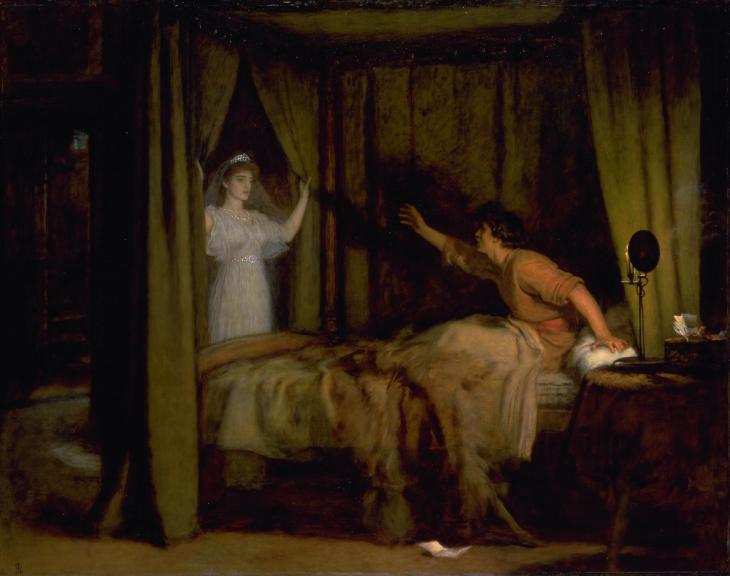When it comes to ghost stories, the Victorians were absolutely the best. It was an era that birthed Industrialism and scientific discovery, yet people held firmly to superstition and folklore. Death closely hovered around every family, regardless of wealth or class. Mourning was so common that there were societal rules about it that were to be strictly observed. When death is an almost palpable part of a culture, it is inevitable that it would be reflected in their literature and art. Ghost stories were embedded in the fabric of Victorian life and neither science nor rational thought could inhibit the lure of a supernatural tale. The possibility of an apparition both frightened and delighted in equal measure. Which, of course, brings me to Sir John Everett Millais’ ghostly painting, a concept that had been on his mind for forty years before he began to paint it.

“The picture tells its own tale. It is that of a young Roman,who has been reading through the night the letters of his lost love; and at dawn, behold, the curtains of his bed are parted, and there before him stands, in spirit or in truth, the lady herself, decked as on her bridal night, and gazing upon him with sad but loving eyes. An open door displays the winding stair down which she has come; and through a small window above it the grey dawn steals in, forming, with the light of the flaring taper at the bedside, a harmonious discord, such as the French school delight in, and which Millais used to good effect in his earlier picture, ” The Rescue”. — The Life and Letters of Sir John Everett Millais
Like his fellow Pre-Raphaelite artists, Millais took great pains to find just the right furniture and props to create his work. You may be familiar with the extremes he took when painting Ophelia, where model Elizabeth Siddal posed in cold water for hours and grew quite ill as a result (see my site LizzieSiddal.com.) For Speak! Speak!,Millais purchased an old four-poster bed and attempted to borrow an antique lamp from a museum. Upon learning that borrowing the lamp was forbidden, the artist drew the object and had an iron worker create a facsimile. Millais’ son remarked that from beginning to end of the work, his father took a romantic interest in the picture.
Punch had an amusing note on the painting that Millais used often to chuckle over, the suggestion being that it represented a young man whose wife had run up a fearful bill for diamonds, and this so haunts him that he has a nightmare in which she appears in a her finery. –The Life and Letters of Sir John Everett Millais
The painting, for me, also brings to mind Wilkie Collins’ The Woman in White. It’s one of my favorite Victorian mysteries and the author and Millais were great friends. Here Millais has created that same spectral presence of a startling woman in white. For more on The Woman in White and other paintings using the symbolism of white-clad ladies, see Gowns so White and Fair.
